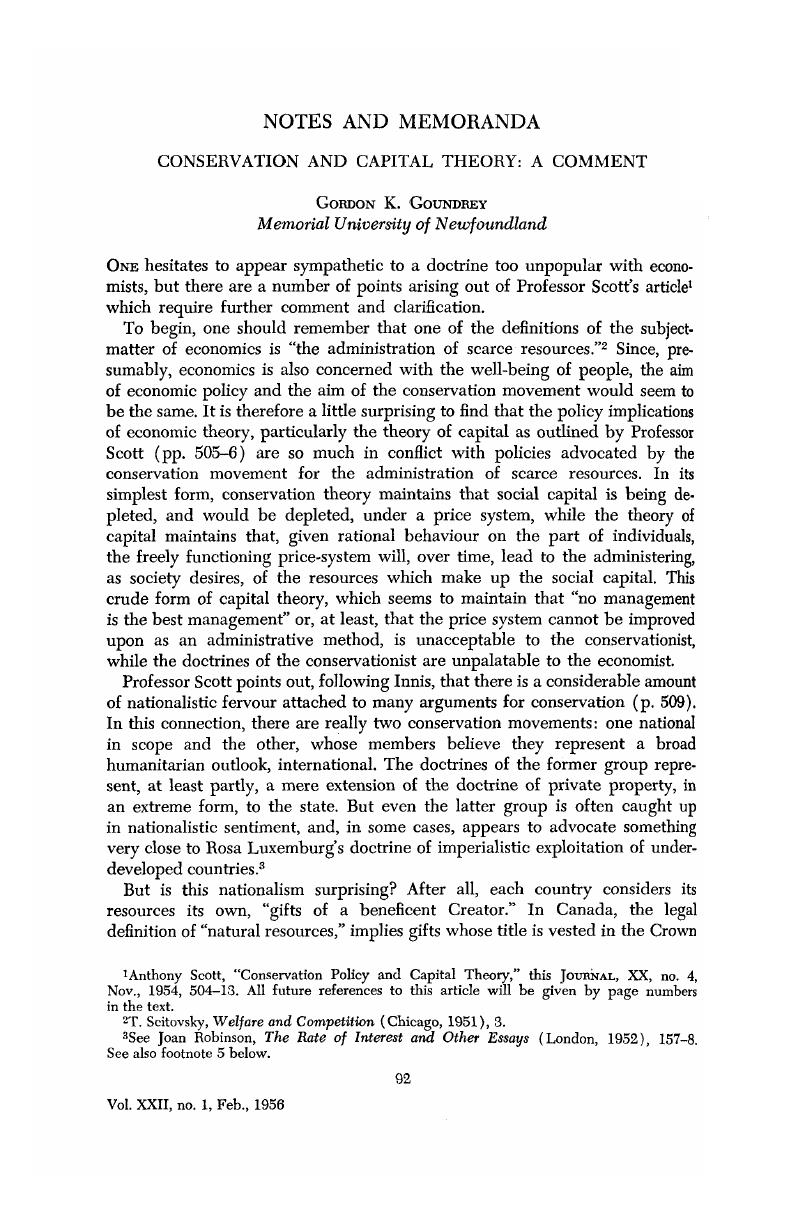No CrossRef data available.
Published online by Cambridge University Press: 07 November 2014

1 Scott, Anthony, “Conservation Policy and Capital Theory,” this Journal, XX, no. 4, 11, 1954, 504–13.Google Scholar All future references to this article will be given by page numbers in the text.
2 Scitovsky, T., Welfare and Competition (Chicago, 1951), 3.Google Scholar
3 See Robinson, Joan, The Rate of Interest and Other Essays (London, 1952), 157–8.Google Scholar See also footnote 5 below.
4 The term “natural resources” has only recently been clearly defined in Canada. See Perry, J. H., Taxation in Canada (Toronto, 1951), 234.Google Scholar Professor Scott uses the term in a slightly different sense (p. 504).
5 See Annals of the American Academy of Political and Social Science, 05, 1952, particularly articles by Bateman, Meyerhoff, and Lamb, .Google Scholar This feeling is also present in Lower, A. R. M., The North American Assault on the Canadian Forest (Toronto, 1938).Google Scholar
6 This is one of the reasons given for the establishment of the Forestry Commission in England as an almost independent board. See also the Report of the Saskatchewan Royal Commission on Forestry (Regina, 1947).Google Scholar
7 See Clough, S. B., The Rise and Fall of Civilization (New York, 1951).Google Scholar
8 Pigou, A. C., Economics of Welfare (8th ed., London, 1948), 25.Google Scholar
9 Shackle, G. S., Expectation in Economics (Cambridge, 1949).Google Scholar
10 Coase, R. H., “The Nature of the Firm,” Economica (N.S.) IV, 1937.Google Scholar See also Hart, A. G., Anticipations, Uncertainty, and Dynamic Planning (Chicago, 1940).Google Scholar
11 See Reddaway, W. F. and Stone, R., Some Difficulties in the Measurement of Real Geographic Product (Cambridge, 1952).Google Scholar
12 Elliott, G. A., “On Some Fashions in Economic Theory,” this Journal, XX, no. 4, 11, 1954, 488.Google Scholar
13 See Scitovsky, T., “A Reconsideration of the Theory of Tariffs,” Review of Economic Studies, IX, 1942, 89–110.CrossRefGoogle Scholar One asks permission to beg the question: what constitutes a better position?
14 Robbins, L. C., The Economic Problem in Peace and War (Cambridge, 1947).Google Scholar
15 In other words, since resources are necessary, the plethora of practically free resources in undeveloped countries, attracting, as they will, investment funds, is antagonistic to the long-run well-being of the home industries of more developed countries. Development abroad, largely resulting from the exploitation of previously unused resources, will cut off foreign supplies of essential materials for home industries, cause international tensions to develop (as a result of the conflict between the vested interests of the industrialists in the more developed (home) areas and the growing nationalism of the developing countries), and seriously retard home industry in the long run. One wonders just how long a country can maintain a high standard of consumption on the basis of techniques alone. Surely technical superiority is a transitory advantage on which to dream of maintaining a great nation. Once again, conservation and nationalism appear to be very close.
16 Except that, to the extent that trade increases efficiency, it reduces the annual drain of resources required to sustain income at a given level. But, if the apparent income is not all income and contains an element of capital depletion, trade allows capital depletion to go on at a more rapid rate.
17 Haberler, G., “Some Factors Affecting the Future of International Trade” in Ellis, H. S. and Metzler, L. A., eds., Readings in the Theory of International Trade (Toronto, 1950), 533.Google Scholar See also Sir Dennis Robertson, “The Future of International Trade,” ibid., 497–513, for an extended discussion of the ephemeral nature of some of the gains from international trade.
18 Hicks, J. R., A Contribution to the Theory of the Trade Cycle (Oxford, 1952), particularly 47–55.Google Scholar His position differs from Mr.Scott's, : “All resources, to a greater or lesser extent, are substitutes for one another” (p. 507).Google Scholar
19 One occasionally hears a proposal for an imaginary war to put unemployed resources in operation during a depression. If the waste of the material resources in such a scheme is as unimportant as a boundless faith in science and technology would lead us to believe, what argument does the economist advance against such an “uneconomic” use of resources?